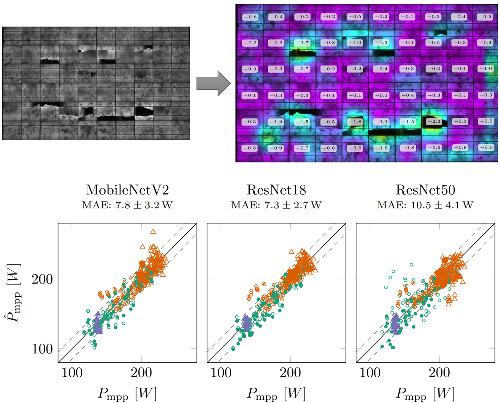当前位置:
X-MOL 学术
›
Prog. Photovoltaics
›
论文详情
Our official English website, www.x-mol.net, welcomes your feedback! (Note: you will need to create a separate account there.)
Deep-learning-based pipeline for module power prediction from electroluminescense measurements
Progress in Photovoltaics ( IF 6.7 ) Pub Date : 2021-05-20 , DOI: 10.1002/pip.3416 Mathis Hoffmann 1, 2 , Claudia Buerhop‐Lutz 3 , Luca Reeb 1, 3 , Tobias Pickel 3 , Thilo Winkler 2, 3 , Bernd Doll 2, 3, 4 , Tobias Würfl 1 , Ian Marius Peters 3 , Christoph Brabec 2, 3, 4 , Andreas Maier 1, 4 , Vincent Christlein 1
Progress in Photovoltaics ( IF 6.7 ) Pub Date : 2021-05-20 , DOI: 10.1002/pip.3416 Mathis Hoffmann 1, 2 , Claudia Buerhop‐Lutz 3 , Luca Reeb 1, 3 , Tobias Pickel 3 , Thilo Winkler 2, 3 , Bernd Doll 2, 3, 4 , Tobias Würfl 1 , Ian Marius Peters 3 , Christoph Brabec 2, 3, 4 , Andreas Maier 1, 4 , Vincent Christlein 1
Affiliation

|
Automated inspection plays an important role in monitoring large-scale photovoltaic power plants. Commonly, electroluminescense measurements are used to identify various types of defects on solar modules, but have not been used to determine the power of a module. However, knowledge of the power at maximum power point is important as well, since drops in the power of a single module can affect the performance of an entire string. By now, this is commonly determined by measurements that require to discontact or even dismount the module, rendering a regular inspection of individual modules infeasible. In this work, we bridge the gap between electroluminescense measurements and the power determination of a module. We compile a large dataset of 719 electroluminescense measurements of modules at various stages of degradation, especially cell cracks and fractures, and the corresponding power at maximum power point. Here, we focus on inactive regions and cracks as the predominant type of defect. We set up a baseline regression model to predict the power from electroluminescense measurements with a mean absolute error (MAE) of 9.0 ± 8.4WP (4.0 ± 3.7%). Then, we show that deep learning can be used to train a model that performs significantly better (7.3 ± 6.5WP or 3.2 ± 2.7%) and propose a variant of class activation maps to obtain the per cell power loss, as predicted by the model. With this work, we aim to open a new research topic. Therefore, we publicly release the dataset, the code, and trained models to empower other researchers to compare against our results. Finally, we present a thorough evaluation of certain boundary conditions like the dataset size and an automated preprocessing pipeline for on-site measurements showing multiple modules at once.
中文翻译:

基于深度学习的基于电致发光测量的模块功率预测管道
自动化检测在监控大型光伏电站中发挥着重要作用。通常,电致发光测量用于识别太阳能模块上的各种类型的缺陷,但尚未用于确定模块的功率。然而,了解最大功率点的功率也很重要,因为单个模块的功率下降会影响整个串的性能。到目前为止,这通常是通过需要断开甚至拆卸模块的测量来确定的,这使得对单个模块进行定期检查是不可行的。在这项工作中,我们弥合了电致发光测量和模块功率确定之间的差距。我们编译了一个包含 719 个模块在不同退化阶段的电致发光测量的大型数据集,特别是电池裂纹和断裂,以及最大功率点的相应功率。在这里,我们将非活性区域和裂纹作为主要的缺陷类型。我们建立了一个基线回归模型来预测电致发光测量的功率,平均绝对误差 (MAE) 为 9.0 ± 8.4WP (4.0 ± 3.7%)。然后,我们展示了深度学习可用于训练性能明显更好的模型(7.3 ± 6.5W P或 3.2 ± 2.7%),并提出类激活图的变体以获得每个单元的功率损失,如预测的那样模型。通过这项工作,我们的目标是开启一个新的研究课题。因此,我们公开发布数据集、代码和训练有素的模型,以使其他研究人员能够与我们的结果进行比较。最后,我们对某些边界条件进行了全面评估,例如数据集大小和用于同时显示多个模块的现场测量的自动化预处理管道。
更新日期:2021-07-16
中文翻译:

基于深度学习的基于电致发光测量的模块功率预测管道
自动化检测在监控大型光伏电站中发挥着重要作用。通常,电致发光测量用于识别太阳能模块上的各种类型的缺陷,但尚未用于确定模块的功率。然而,了解最大功率点的功率也很重要,因为单个模块的功率下降会影响整个串的性能。到目前为止,这通常是通过需要断开甚至拆卸模块的测量来确定的,这使得对单个模块进行定期检查是不可行的。在这项工作中,我们弥合了电致发光测量和模块功率确定之间的差距。我们编译了一个包含 719 个模块在不同退化阶段的电致发光测量的大型数据集,特别是电池裂纹和断裂,以及最大功率点的相应功率。在这里,我们将非活性区域和裂纹作为主要的缺陷类型。我们建立了一个基线回归模型来预测电致发光测量的功率,平均绝对误差 (MAE) 为 9.0 ± 8.4WP (4.0 ± 3.7%)。然后,我们展示了深度学习可用于训练性能明显更好的模型(7.3 ± 6.5W P或 3.2 ± 2.7%),并提出类激活图的变体以获得每个单元的功率损失,如预测的那样模型。通过这项工作,我们的目标是开启一个新的研究课题。因此,我们公开发布数据集、代码和训练有素的模型,以使其他研究人员能够与我们的结果进行比较。最后,我们对某些边界条件进行了全面评估,例如数据集大小和用于同时显示多个模块的现场测量的自动化预处理管道。



























 京公网安备 11010802027423号
京公网安备 11010802027423号